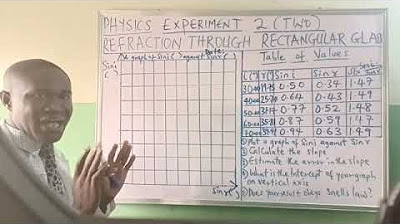EMC Part 24. Why Electric Fields Reflect at the 1st Boundary of a Shield but Magnetic Fields Do Not.
Summary
TLDRThis video continues the discussion on EMC considerations, specifically focusing on shielding effectiveness and the concept of refraction. It covers how electric and magnetic fields interact with shielding boundaries, explaining wave impedance, reflection, and penetration. The video highlights the behavior of electric and magnetic fields at the first and second boundaries, detailing how electric fields are mostly reflected at the first boundary but penetrate through the second, while magnetic fields mostly pass through the first but are reflected at the second. A technical breakdown of the key equations and variables used in this analysis is also provided.
Takeaways
- 😀 This video is part of a continuing series on EMC considerations, focusing on shielding effectiveness and refraction.
- 😀 The script emphasizes the importance of supporting the channel to promote educational content over entertainment.
- 😀 The equations discussed in the video define how incident waves interact with two boundaries, with different behaviors for electric and magnetic fields.
- 😀 The electric field has a high wave impedance, meaning most of the incident wave is refracted back at the first boundary.
- 😀 The magnetic field, on the other hand, has a smaller wave impedance, allowing most of the incident magnetic wave to penetrate through the first boundary.
- 😀 For the electric field, most of the wave is reflected at the first boundary, while very little penetrates through the second boundary.
- 😀 For the magnetic field, most of the wave penetrates through the first boundary, but at the second boundary, it is mostly reflected back.
- 😀 The wave impedance of electric fields is much higher than that of magnetic fields, which influences how waves behave when encountering boundaries.
- 😀 The second boundary allows more penetration for electric fields, with very little reflection, while magnetic fields experience a significant reflection at the second boundary.
- 😀 The video provides a deeper understanding of how electric and magnetic fields behave differently when they interact with shields, depending on wave impedance and boundary conditions.
Q & A
What is the main topic of the video discussed in the script?
-The main topic is Electromagnetic Compatibility (EMC), specifically focusing on the shielding effectiveness and how electromagnetic waves behave when interacting with a shield.
What is the significance of the first and second boundaries in the context of shielding?
-The first and second boundaries refer to the interfaces between the electromagnetic wave and the shield material. The behavior of the wave—whether it is reflected or penetrates through—depends on these boundaries and the properties of the shield.
How do electric fields behave when they interact with the shield?
-When the electric field interacts with the shield, most of it is reflected at the first boundary. A small portion penetrates the shield and, upon reaching the second boundary, most of the electric field successfully passes through.
How do magnetic fields behave when they interact with the shield?
-Magnetic fields behave differently. Upon hitting the shield, most of the magnetic field penetrates the first boundary, and very little is reflected back. However, at the second boundary, most of the magnetic field is reflected, and only a small amount penetrates.
What role does wave impedance play in the interaction of waves with the shield?
-Wave impedance determines how much of the wave is reflected and how much is transmitted through the shield. A high wave impedance, as seen with electric fields, results in more reflection at the first boundary, while a low wave impedance, as seen with magnetic fields, allows more penetration through the first boundary.
What is the relationship between Z1 and Z2 in the equations for electric and magnetic fields?
-Z1 represents the wave impedance for the electric field, which is much higher than Z2, the wave impedance for magnetic fields. This difference causes electric fields to reflect more at the first boundary, while magnetic fields penetrate more.
What happens to the electric field after passing through the first boundary?
-After passing through the first boundary, the electric field continues to penetrate the shield and, at the second boundary, most of the electric field successfully passes through, with very little being reflected back.
Why is there minimal reflection of the electric field at the second boundary?
-At the second boundary, the impedance of the shield is such that most of the electric field is transmitted through because the wave impedance is more favorable for transmission at this point.
What is the main difference between the behavior of electric and magnetic fields when they reach the second boundary?
-The electric field mostly passes through the second boundary, while the magnetic field is reflected at the second boundary, with very little magnetic field penetrating through.
How can the equations derived in the video help in understanding shielding effectiveness?
-The equations help in quantifying how the wave impedance affects the reflection and penetration of waves at both the first and second boundaries of the shield, providing a mathematical explanation for the observed behavior of electric and magnetic fields.
Outlines

Cette section est réservée aux utilisateurs payants. Améliorez votre compte pour accéder à cette section.
Améliorer maintenantMindmap

Cette section est réservée aux utilisateurs payants. Améliorez votre compte pour accéder à cette section.
Améliorer maintenantKeywords

Cette section est réservée aux utilisateurs payants. Améliorez votre compte pour accéder à cette section.
Améliorer maintenantHighlights

Cette section est réservée aux utilisateurs payants. Améliorez votre compte pour accéder à cette section.
Améliorer maintenantTranscripts

Cette section est réservée aux utilisateurs payants. Améliorez votre compte pour accéder à cette section.
Améliorer maintenantVoir Plus de Vidéos Connexes
5.0 / 5 (0 votes)






